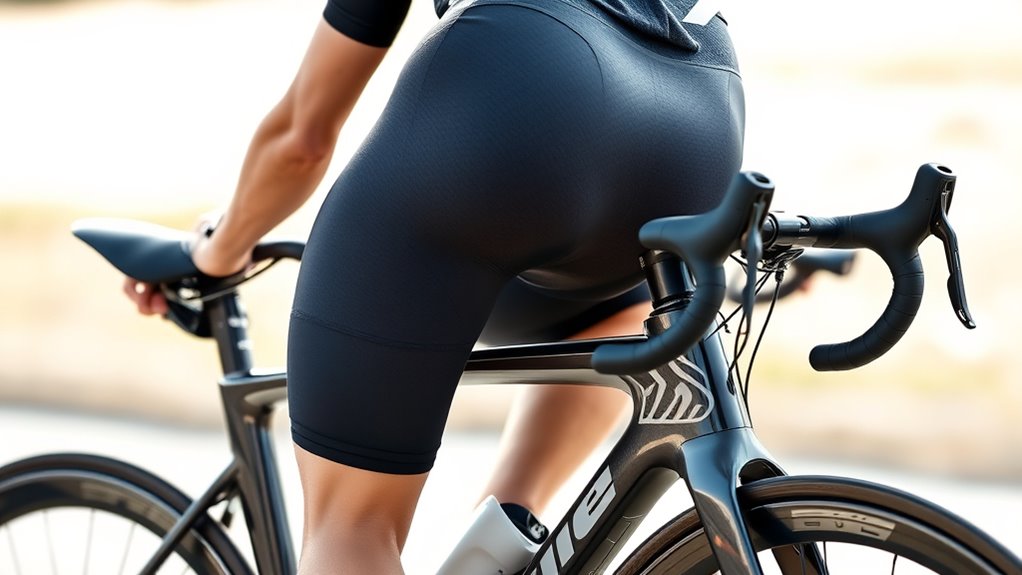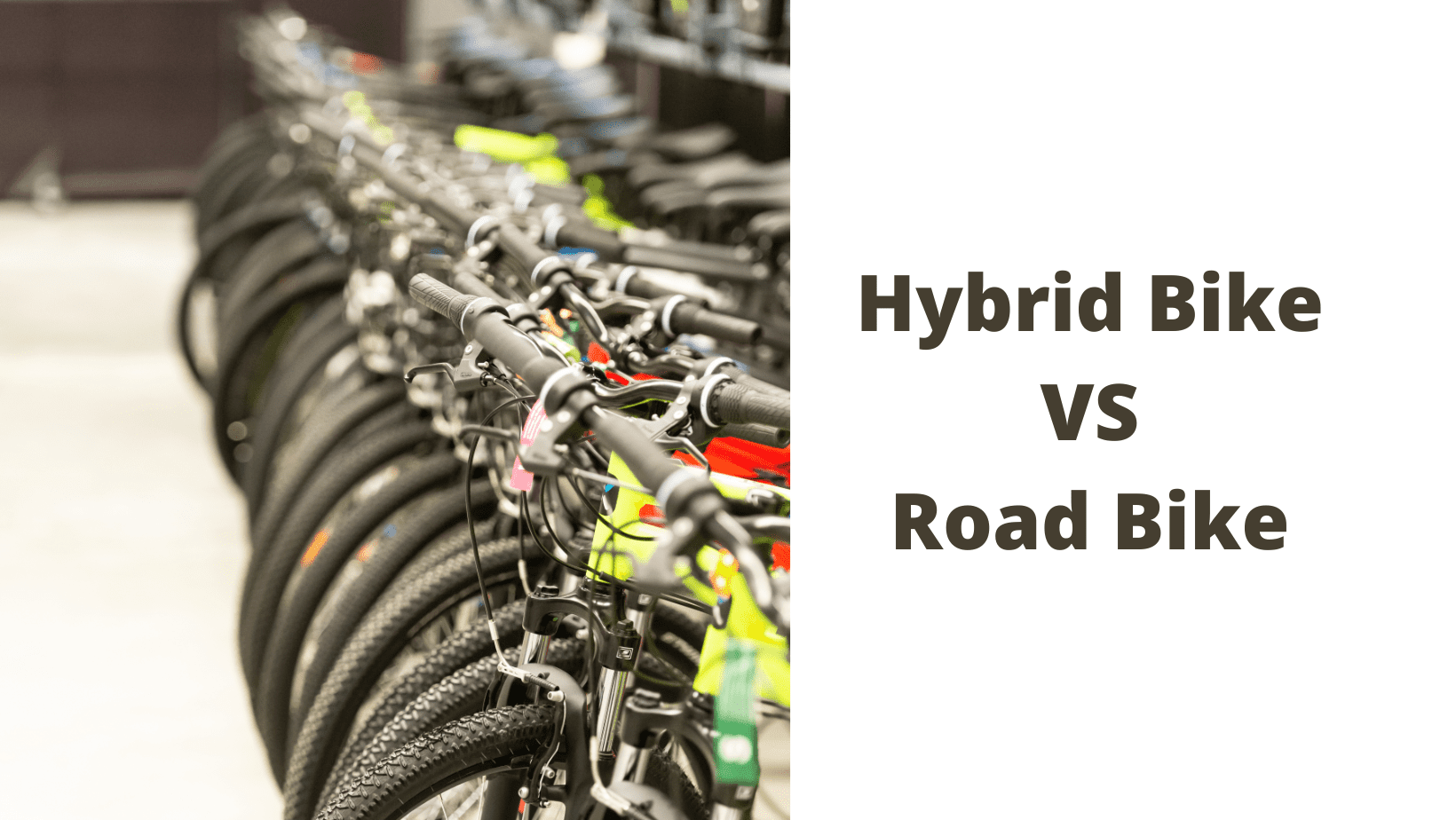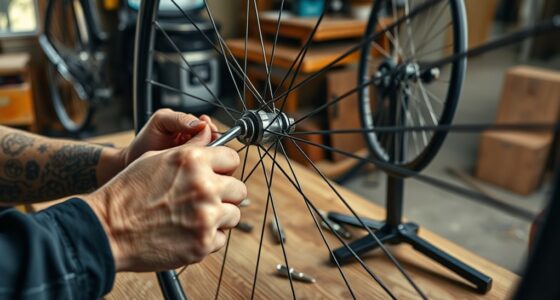Proper ergonomics boost your cycling performance by ensuring your bike fit aligns with your body, which improves power transfer and reduces fatigue. Adjusting saddle height, handlebar reach, and posture helps prevent discomfort and injuries while optimizing aerodynamics for greater speed. Maintaining the right body position also conserves energy during long rides. Keep tuning your setup, and you’ll unleash your full potential—exploring more ways to enhance comfort and efficiency.
Key Takeaways
- Proper bike fit improves contact points, reducing energy loss and increasing power transfer during pedaling.
- Ergonomic adjustments distribute pressure evenly, preventing discomfort and muscle strain for sustained performance.
- Optimized posture minimizes wind resistance, enhancing aerodynamics and allowing higher speeds with less effort.
- Correct ergonomic setup reduces injury risk by ensuring proper alignment and preventing joint and tissue stress.
- An ergonomic bike fit enhances comfort on long rides, conserving energy and boosting endurance over extended distances.
The Impact of Proper Bike Fit on Power Transfer and Efficiency

A proper bike fit directly influences how effectively you transfer power to the pedals and how efficiently you ride. When your saddle height, handlebar reach, and cleat positioning are optimized, it enhances your contact points and promotes better body alignment. This ergonomic setup reduces unnecessary movements and minimizes energy loss, allowing you to channel more pedaling force into forward motion. Fine-tuning your bike geometry to match your body proportions ensures sustained riding without fatigue or strain. Correctly aligned contact points produce more efficient power transfer during each pedal stroke, boosting your cycling efficiency. Studies show that riders with a professional bike fit can generate up to 15% more power and enjoy greater endurance, highlighting the importance of proper bike fit for maximizing performance.
How Ergonomic Adjustments Reduce Fatigue and Prevent Discomfort

Proper ergonomic adjustments play a crucial role in reducing fatigue and preventing discomfort during cycling. When you optimize your bike fit, you guarantee even pressure distribution across contact points like the saddle and handlebars, which minimizes muscle tension and joint strain. Maintaining a proper cycling posture with relaxed shoulders and slightly bent elbows helps delay fatigue. Fine-tuning components based on your body biomechanics reduces unnecessary effort, boosting endurance. Regular ergonomic assessments keep your body moving efficiently and comfortably, preventing repetitive strain injuries. Additionally, considering the impact of poor ergonomics on overall performance can motivate consistent adjustments to maintain comfort and efficiency. Recognizing the importance of proper posture can further enhance your cycling experience and prevent long-term injuries. Staying aware of your ergonomic setup ensures that you maintain optimal comfort throughout your rides. Implementing ergonomic principles from Honda tuning can provide valuable insights into customizing your cycling position for maximum performance and comfort. Moreover, understanding ergonomic best practices helps in developing a routine that supports long-term health and peak performance.
The Role of Body Posture in Maximizing Aerodynamics and Speed
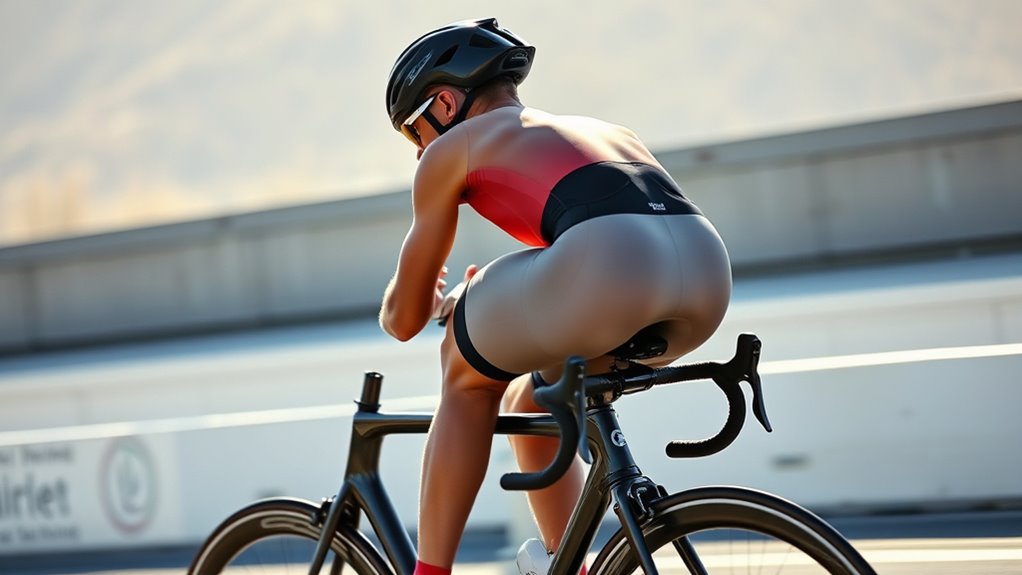
Maintaining an ideal body posture is essential for maximizing aerodynamics and increasing your cycling speed. Your riding position directly influences airflow and wind resistance, impacting overall cycling performance. By adopting a low, streamlined posture, you reduce your frontal surface area, decreasing air resistance by up to 30%. Proper ergonomic positioning aligns your torso parallel to the ground, optimizing airflow and minimizing drag. A slight forward lean and engaged core help stabilize your aerodynamic profile, allowing you to sustain high speed over long distances. Adjusting handlebar height and reach encourages a more streamlined riding position, reducing unnecessary wind resistance caused by upright postures. Proper ergonomic positioning also helps prevent discomfort and injuries, ensuring sustained performance over time. Additionally, incorporating ergonomic adjustments can enhance comfort, enabling you to ride longer distances without fatigue. Ensuring your bike fit is suitable for your body proportions can further improve ergonomic efficiency, contributing to better overall performance. Maintaining correct head and neck alignment is also crucial for comfort and aerodynamics, helping you sustain optimal posture during extended rides. Regularly checking and fine-tuning your bike ergonomics can help you maintain an efficient aerodynamic profile, translating to faster speeds and less fatigue during your ride.
Preventing Injuries Through Ergonomic Design and Setup
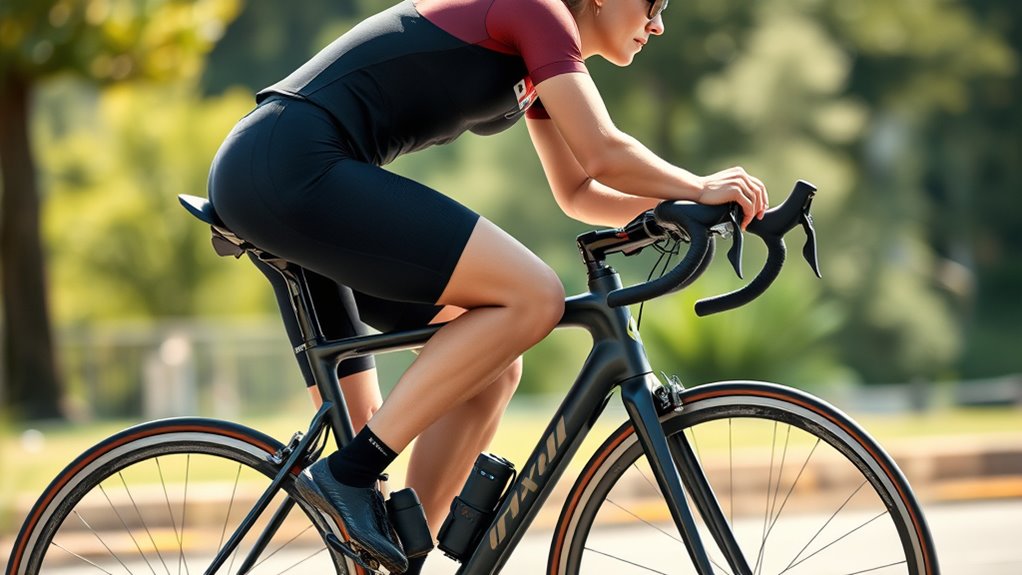
Have you ever experienced discomfort or pain after a long ride? That’s often due to poor ergonomic bike setup. Ensuring a proper bike fit helps prevent injury by optimizing body alignment and weight distribution. Adjust your saddle height and fore-aft position to reduce knee and lower back strain. Proper handlebar position, reach, and grip help avoid musculoskeletal injuries by promoting natural arm and shoulder alignment. Incorporating ergonomic accessories like padded gloves and shock-absorbing saddles minimizes vibration and tissue stress. Regular bike fit assessments and fine-tuning are essential for injury prevention, keeping your biomechanics aligned during different terrains and rides. When your ergonomic bike setup is correct, cycling comfort increases, and the risk of nerve compression and repetitive strain injuries drops considerably. Paying attention to body positioning and making adjustments based on comfort can further enhance your ride quality and safety. Additionally, understanding ergonomic principles can guide you in selecting optimal components and accessories tailored to your body type and riding style.
Long-Distance Cycling: Enhancing Endurance With Optimal Ergonomics

Optimizing your ergonomic setup during long-distance cycling can substantially boost endurance and reduce fatigue. Proper bike fit, including saddle height and handlebar position, ensures comfort and efficiency, allowing you to sustain longer rides. Adjusting your body posture—relaxed shoulders and a slight forward lean—not only improves aerodynamics but also conserves energy. Using padded apparel and shock-absorbing components adds comfort, helping you endure extended periods without discomfort. Regular breaks and posture resets prevent strain and keep your body aligned. Fine-tuning your bike fit enhances power transfer and minimizes overuse injuries, essential for endurance cycling. Incorporating bike maintenance and proper gear shifting techniques can further improve your ride quality and safety. Ensuring your ergonomic setup is tailored to your individual needs can significantly impact your performance and comfort during long rides. Additionally, selecting the right cycling accessories can improve overall ergonomics and reduce fatigue. Adopting effective riding ergonomics makes long-distance rides more manageable, boosting your stamina and preventing fatigue-related issues. Overall, ergonomic cycling strategies are indispensable for maximizing performance during long-distance rides. Incorporating proper body posture into your routine can also help prevent injury and promote better overall comfort during extended rides.
Frequently Asked Questions
What Are the Ergonomics for Cycling?
Ergonomics for cycling involves adjusting your bike to match your body, ensuring comfort and efficiency. You should focus on proper saddle height, handlebar reach, and cleat positioning to achieve the best posture. These adjustments help reduce strain, prevent injuries, and improve your riding experience. By tailoring your bike fit to your unique body and riding style, you’ll ride more comfortably, faster, and with less fatigue.
What Is the Best Posture for Cycling?
Think of your body as a finely tuned instrument, and the best cycling posture is the melody. You want to keep your spine neutral with a slight forward tilt, elbows bent comfortably, and shoulders relaxed. Maintain a saddle height that allows a 25-30° knee bend, keep your head up and gaze forward, and distribute weight evenly. Fine-tune handlebar reach to stay comfortable, efficient, and injury-free during long rides.
What Is the Correct Posture for a City Bike?
For a city bike, you should sit with a relaxed, upright posture, keeping your back straight and shoulders level to stay comfortable. Position the handlebars at or just above saddle height to avoid strain. Keep your elbows slightly bent and close to your body for control and shock absorption. Adjust your saddle so your knee has a slight bend at the pedal’s lowest point, ensuring efficient pedaling.
How to Cycle Correctly?
To cycle correctly, focus on maintaining a smooth, circular pedaling motion with even pressure. Keep your core engaged and shoulders relaxed to boost efficiency and reduce fatigue. Position yourself with a slight forward lean and neutral spine for better aerodynamics and power transfer. Adjust your saddle height and handlebar reach for comfortable biomechanics. Practice cadence and gear shifting regularly to improve your riding efficiency and endurance.
Conclusion
Think of your bike setup as the steering wheel of your performance ship. When your ergonomics are dialed in, you navigate the roads smoothly, conserving energy and boosting speed. Proper adjustments aren’t just comfort—they’re your secret compass to better power transfer, reduced fatigue, and injury prevention. By prioritizing your body’s best fit, you’ll sail further and faster, turning every ride into a confident voyage toward your cycling goals.
